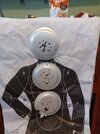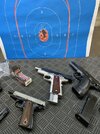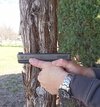thunderbyrd
Member

i provide the above photo for your amusement. this was my latest range visit. you will notice that i have taped 3 small paper plates to my target. this is because without them i have a hard time seeing where my rounds are hitting, especially on a black target. this is about 7-8 yards.
this actually is about the best, most accurate shooting i've done, and i know it's not great. i only know of two ways to improve: go work out at the range, which gets expensive, and dry firing. i notice that whenever you guys post targets, all of you shoot much better than me. SO i am interested in various dry firing techniques/routines that you use.






